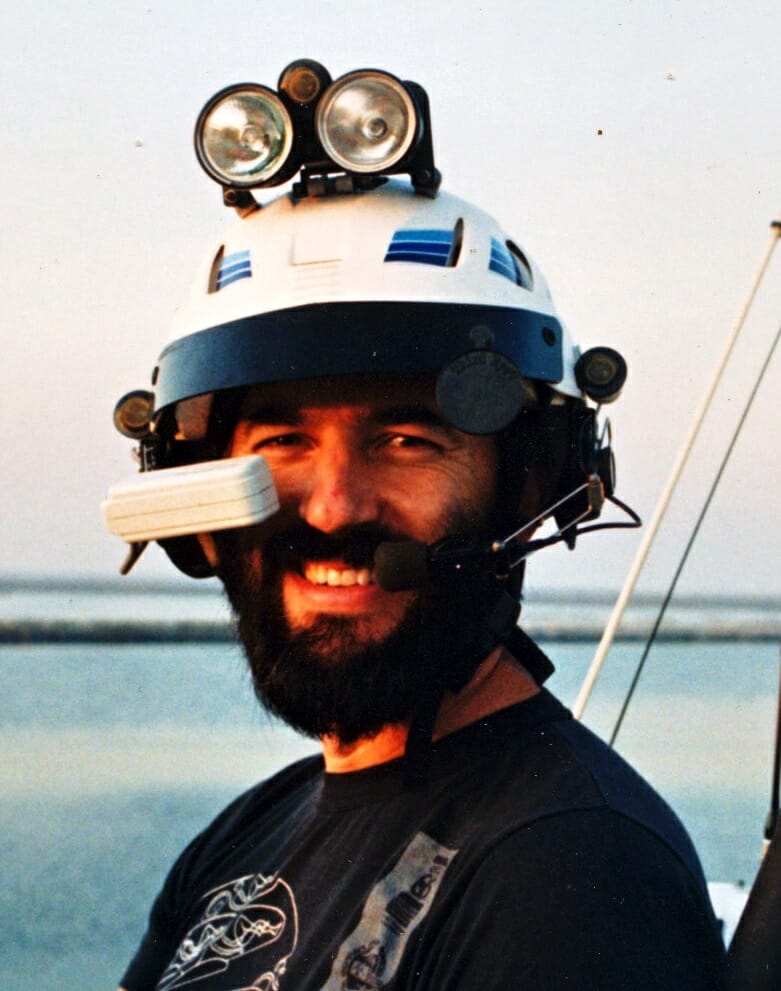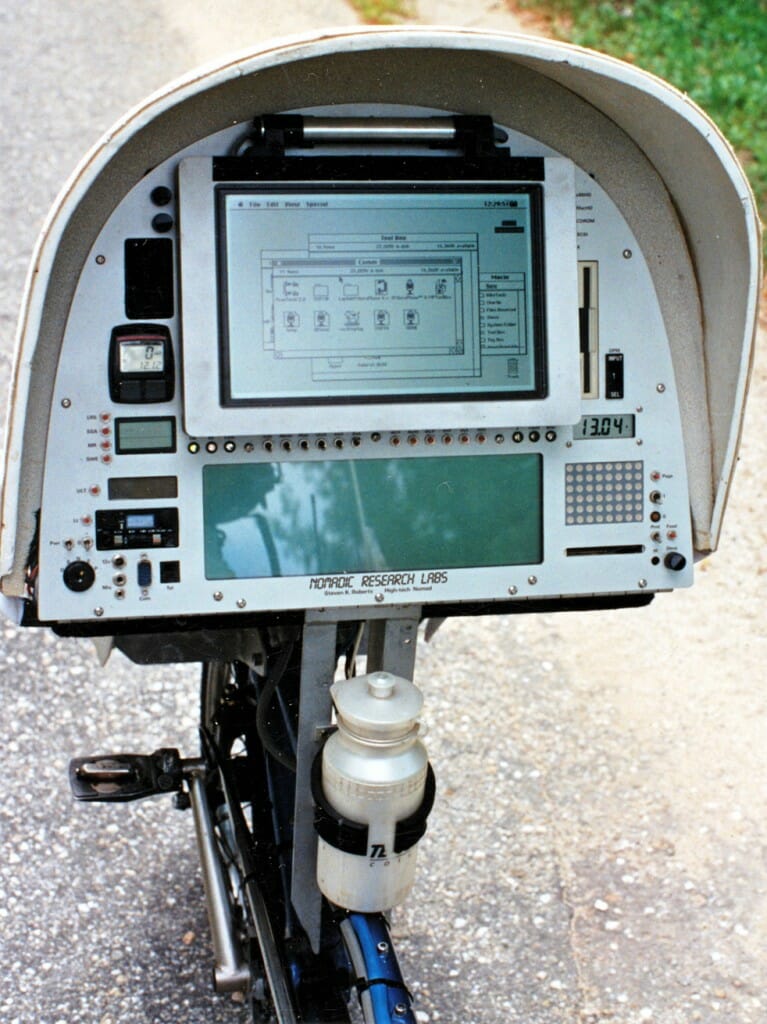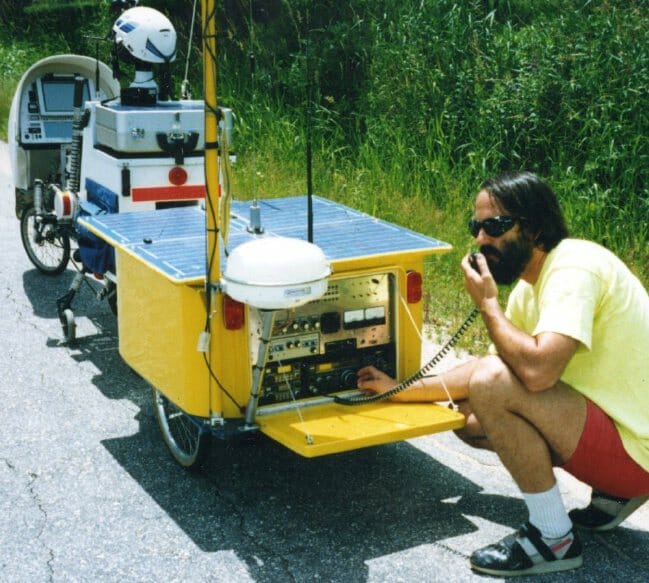
Packet Radio and High-Tech Nomadics
These magazine articles from the early phase of BEHEMOTH development are kind of a treasure… I had not yet started posting the details to a mailing list, and there aren’t many documents that go into detail about the system design. My series in 73 Magazine was very liberal, editorially… so I was free to ramble and philosophize at will. This one takes a deep dive into the packet data communication applications, before the bike was even named BEHEMOTH.
A sneak preview of the Winnebiko III
by Steven K. Roberts, N4RVE
73 Magazine
October, 1989
If you’ve been reading 73 for over a year, you’ve already had a look at the Winnebiko II — the computerized, ham radio-equipped recumbent bicycle that I’ve pedaled 16,000 miles around the United States. And if you were a regular reader of my article series, you even might have wondered what happened; I’ve received a few pieces of packet mail asking if I’ve been run over by a truck.
Well, if I’ve been struck by anything at all, it’s the passion to create new machines. Maggie KA8ZYW and I are currently in a year-long Silicon Valley layover, building all-new bike systems and preparing to hit the road for many years of open-ended international travel. The project has been escalated to a new level, with the design specification now calling for maximum independence from support facilities of any kind. Indeed, this has become an all-out effort aimed at creating a self-maintaining mobile information platform, constantly in communication with worldwide voice and data networks while freely wandering the Earth’s surface under human and solar power.
Winnebiko III Architecture
Packet radio is a key component in the system, but before a description of its implementation can make sense, you need a quick look at the whole machine. One disclaimer: This is an overview of work-in-progress, and there may be a few discrepancies between what is stated here and what actually rolls out the door this winter.
There are two major electronic areas in the new machine. Up front in the streamlined console are all computer and control systems, and back in the solar-roofed trailer are the rackmount ham shack and power management hardware. Between the two sit the wetware information system and bio-engine, coupled to the rest of the machine via a variety of interfaces that include a heads-up display, ultrasonic head-position sensor for display control, speech I/O, handlebar keyboard, active Peltier-effect scalp-cooling system, thumb mouse, and random controls. Oh yes — and pedals.
The controller for the whole machine (one level down from the human, that is) is an eminently hackable CMOS 68000 running FORTH. It’s in charge of the local area network that connects all other information systems and 68HC11 microcontrollers, as well as a giant “resource bus” based on Mitel crosspoint switches and AMD programmable gate arrays. Through this array pass all audio, serial, power-control and status signals, making it extremely easy to establish connections between subsystems that I might not originally intend to interface. Also in the console system are a pair of DOS environments for AutoCAD, OrCAD, mapping, satellite tracking, text editing, database management, and communications. On top of this there’ll be a significant new machine, still proprietary, that I’ll reveal in a later article, as well as a dedicated 68HC11 for data collection and a few stand-alone intelligent devices for navigation, speech, and so on.
All this provides extensive real-time processing horsepower and a very friendly user interface — with a VGA backlit display, a 640 x 200 LCD for the FORTH, a flip-down hi-res screen, and the heads-up display as graphics options. But now that I can compute as much as I want, how do I communicate with the rest of the world?
The trailer system carries the bulk of the radio gear (not including the cellular phone, the 56-kilobaud spread-spectrum data link, a Swintek full-duplex wireless intercom for security monitoring, and an embedded ICOM μ2AT in the console for bike-to-bike chat). The radio gear takes the form of a shock-mounted 19″ equipment rack accessible through a fold-down rear door, along with a collapsible antenna mast for the OSCAR-13 array and whips, a permanent 70cm collinear for Microsat operation, and the usual bag of dipoles and accessories.
The rack-mounted gear includes ICOM’s new 725 (modified for low-power drain), a pair of Yaesu multimode 290/790 transceivers for both OSCAR and terrestrial VHF/UHF operation, a pair of ARR preamps, an AEA ATV transceiver, an antenna tuner and coax patch panel, an MFJ/Bencher keyer, a power-entry module for AC line interface to the bike’s 12 volt bus, a regenerative braking controller, yet another 68HC11 for trailer data collection and local control, and two of the bike’s three main batteries. Maggie’s bike, in case you’re wondering, carries a Yaesu 290 and Ranger 3500 for 2 meter and 10 meter multimode operation.
But where does packet fit in all this?
Bicycle Datacomm
For the last three years I’ve been running bicycle-mobile packet via PacComm’s first- generation TNC, the bike’s computer, and the handlebar keyboard. This has been a fairly low-level manual operation, with a few tentative stabs at maintaining a mobile BBS, but no real autonomy in the datacomm and message-passing realms.
The new system is different, and uses packet in three ways.
First, I carry both a PacComm Micropower-2 and an MFJ 1278 for “traditional” packet radio use. The MFJ multimode unit, modified with all SMOS components to minimize power drain, is for browsing the HF spectrum in search of interesting FAX, RTTY, and AMTOR contacts. The 35 mA PacComm is for 2-meter packet and has a big FET switch on the modem disconnect to accommodate a TAPR PSK demodulator for the Microsats. In both cases, operation is via the handlebar keyboard and any of the display spaces when I’m mobile, or via a laptop when I’m parked.
The difference between mobile and parked operation has spawned the second major packet addition to the system. Last time, the robust machine was my laptop, and the on-board computer was fairly wimpy. With that setup, I had no particular interest in using the bike machine when parked, and happily immersed myself in the H-P system instead. But now the bike’s Ampro 286 with a 40-meg hard disk and 4-meg RAMdisk (along with other extensive processing resources) makes carrying a high-end laptop seem a bit unnecessary. The problem, however, is that I don’t particularly want to sit on the bike working for hours when I’m not actually riding it.
The solution is simple. A pair of PacComm surface-mount TNCs — one on the bike and one in my backpack — are linked to each other via 2 watt Maxon business-band UHF data radios (which require a separate license). When I’m off the bike, the only hardware left active is this data link and a security system. If I want to access bike resources for any reason, I can flip open the backpack, bring up a communication program, and sign on from up to three miles away.
The first level of response from the bike is the mini-PBBS in the PacComm, which, unlike the typical TNC, lets me send a data packet that writes directly to a parallel port. A keyword does the trick, booting up the 68000 system through a power controller and presenting me with its FORTH command line. I now have full control of the system and can check telemetry data, dial out via cellular phone, boot up the 286 and access a database, power up and operate the ICOM 725, or send speech strings for local output via the Audapter speech synthesizer. The whole bike, except for the wheels, is completely remote-controlled… for everything is computer-controlled.
The third major packet application on the Winnebiko III involves the orbiting BBSs scheduled for launch this November — AMSAT’s quartet of Microsats. The details will clarify as the system comes together, but preliminary discussions indicate that wherever in the world we travel, my bike will periodically run a satellite tracking program, power up the Yaesu system at the appropriate times, scan with the TAPR demodulator’s feedback until the bird is acquired, then automatically exchange text files and upload the latest block of telemetry data (including our precise location derived from GPS satellites). All this will be piped through “mission control” in the States, with the data parsed and retransmitted to other nodes as appropriate. It seems likely that this will become a significant component of my non-business E-mail traffic — and provide a spirited demo of Microsat technology: a guy wandering the world on a bicycle easily tracked to within a few hundred feet from someone’s ham shack.
Fellow hams, we have some amazing technology in this subculture of ours!
The PR Component
I’d like to make a quick comment on a related issue. Recent discussion on both wireline and packet nets has revealed the disturbing fact that the new director of the FCC is Sharree Marshall, an ex-employee of the law firm that has represented UPS in its successful bid for the 220-222 MHz portion of the amateur spectrum.
We hams have more of a problem than ever. The days of taking spectrum space for granted are quickly passing, as alluring new technologies compete for consumer dollars. The UPS crisis is just the first obvious loss: there are a lot of people out there (and I know some of them) who want — and will aggressively fight for — our space. We have a few advocates in high places, but not enough, and we can no longer assume that someone will take care of the problem for us.
One contribution that every ham can make is public relations. I’m doing some by integrating ham radio into a high-tech, upbeat lifestyle and writing about it for non-ham publications. Others can score PR points by fixing public problems, getting school kids excited, passing traffic to world trouble spots, inventing nifty gizmology and making it clear that it grew out of ham radio, publishing callsigns with technical papers, and generally doing anything possible to bring our image into the current century.
Yes, it’s all image, just like any other kind of marketing. It may at times seem blatant and artificial, but that’s how the world works.
Here’s the test: Take an average person off the street, expose him or her to a few minutes of typical repeater chatter and HF commentary about weather and equipment, then pose the question, “Which is the better use of a 2 MHz piece of the spectrum, improving the speed and efficiency of your UPS deliveries or giving these guys more room to talk to each other?” Until that average person springs to our defense with the very arguments we’ve been making to each other for the last 50 years, we have a problem.
This article is ostensibly about bicycle-mobile packet, so with that timely little diatribe about the future of all this equipment I’m pedaling, I’ll close. As the next few months pass, you’ll be hearing from me in growing detail about the new systems, until we’re finally on the road and on the air again… where we belong.
—73 de N4RVE







You must be logged in to post a comment.